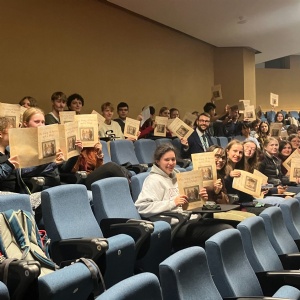
The Song of Arms and a Man – a review by Year 12 student Alison H
Published on 30/01/24

Year 12 student Alison H tells us all about the trip to see “The Song of Arms and a Man”.
In November an eager bunch of classicists from Years 11-13 went to see The Song of Arms and a Man, a selection of dramatic readings from an integral classical text: the Aeneid. These retold the tale of the Aeneid and were replete with summaries presented in English, as well as surtitles. You may ask (as, much to the dismay of Miss Whitelaw, I did) why this retelling of Virgil’s Aeneid was entitled the ‘Song of Arms and a Man’? Some of the less classically-inclined among you may be wondering what the upper limbs have to do with Aeneas. Perhaps you are even wondering who Aeneas was….Well, the first words of Virgil’s Aeneid are ‘I sing of arms and of the man’ (arma virumque cano), the man being Aeneas and the arms being his weapons.
When we entered the auditorium, I noticed an odd sound. At first I thought it was the ventilation, but I gradually realised that there was something - different - about the noise in the theatre. Then I looked down and I realised that the strange humming noise was an aulos, an ancient dual recorder with a hypnotic quality. For me, this instrument, which progressed from its simple hum, was a highlight of the performance, its notes perfectly matching the tone of the spoken Latin and enhancing the metrical rhythm of the verse. Amelie, my notably musically-inclined friend, informed me that the gentleman was using circular breathing, an incredibly difficult technique which takes years to master in which the player breathes in through his nose and out through his mouth.
Having encountered various parts of the Aeneid in lessons since Year 7, and even having read it in its entirety, it was a treat to be able to see it done as Virgil intended (performed aloud, not read) and to experience the effects that the sound of the Latin conveyed to the meaning.